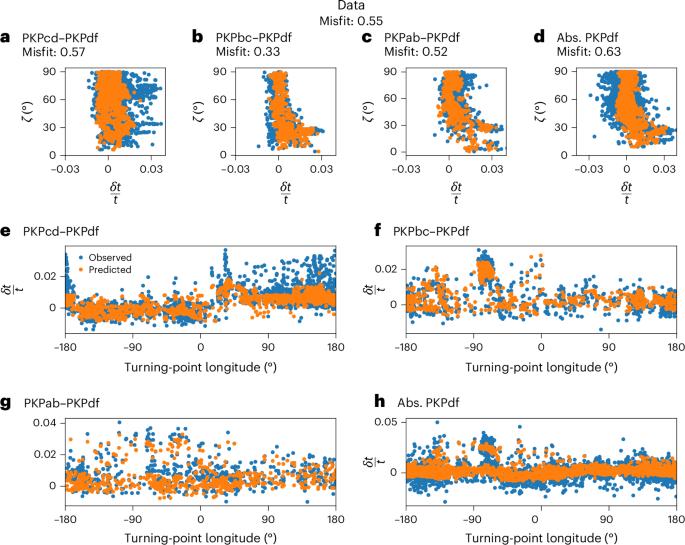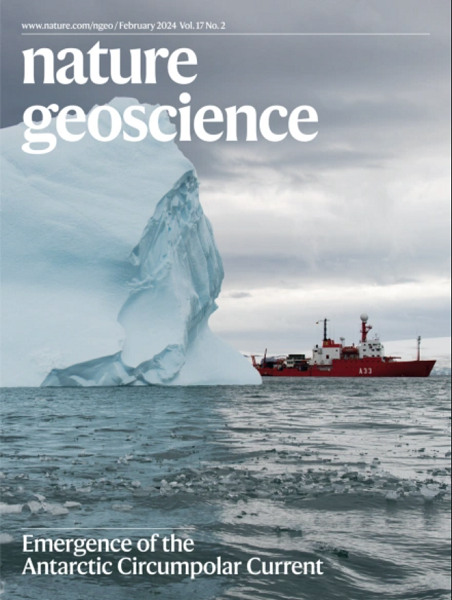Tilted transverse isotropy in Earth’s inner core
IF 15.7
1区 地球科学
Q1 GEOSCIENCES, MULTIDISCIPLINARY
引用次数: 0
Abstract
Seismic waves traversing the inner core in a direction parallel to Earth’s rotation axis arrive faster than waves travelling in the equatorial plane. These observations have been explained in terms of a transversely isotropic inner-core model with a fast symmetry axis parallel to the rotation axis. In recent years, more complex models of the inner core have been developed containing strong regional variations such as hemispheres, isotropic layers and an innermost inner core, most of which assume spatially variable transverse isotropy with a fixed symmetry axis. Here we instead explain the travel times of inner-core-sensitive seismic waves in terms of tilted transverse isotropy, in which the magnitude of transverse isotropy is fixed, but the orientation of the symmetry axis is allowed to vary spatially. This model, derived from seismic tomography, fits travel time data and spatially variable fixed-axis models, yet requires fewer parameters. It features a central inner core with a strong alignment of the fast symmetry axis in the direction of Earth’s spin axis and two shallow caps beneath the Mid-Atlantic and the Indian Ocean/Indonesia regions with symmetry axes tilted towards the equatorial plane. This model indicates the potential for varying crystal orientations within the inner core, which would constrain inner-core dynamics. A seismic tomographic model shows that the directional dependence of the travel time of seismic waves through Earth’s inner core can be explained by a spatially varying orientation of the transverse isotropy symmetry axis, which is simpler than other proposed structures.


地球内核的倾斜横向各向同性
以平行于地球自转轴的方向穿越内核的地震波比在赤道面上传播的地震波到达得更快。这些观测结果可以用横向各向同性的内核模型来解释,该模型的快速对称轴与自转轴平行。近年来,人们开发了更复杂的内核模型,其中包含强烈的区域变化,如半球、各向同性层和最内层内核,大多数模型都假定具有固定对称轴的空间可变横向各向同性。在这里,我们用倾斜横向各向同性来解释内核敏感地震波的传播时间,即横向各向同性的大小是固定的,但对称轴的方向允许在空间上变化。该模型源于地震层析成像技术,符合旅行时间数据和空间可变的固定轴模型,但所需参数较少。该模型的特点是:中央内核的快速对称轴与地球自转轴方向高度一致;大西洋中部和印度洋/印度尼西亚地区下方有两个浅盖,其对称轴向赤道平面倾斜。该模型表明,内核的晶体取向有可能发生变化,这将制约内核动力学。
本文章由计算机程序翻译,如有差异,请以英文原文为准。
求助全文
约1分钟内获得全文
求助全文
来源期刊

Nature Geoscience
地学-地球科学综合
CiteScore
26.70
自引率
1.60%
发文量
187
审稿时长
3.3 months
期刊介绍:
Nature Geoscience is a monthly interdisciplinary journal that gathers top-tier research spanning Earth Sciences and related fields.
The journal covers all geoscience disciplines, including fieldwork, modeling, and theoretical studies.
Topics include atmospheric science, biogeochemistry, climate science, geobiology, geochemistry, geoinformatics, remote sensing, geology, geomagnetism, paleomagnetism, geomorphology, geophysics, glaciology, hydrology, limnology, mineralogy, oceanography, paleontology, paleoclimatology, paleoceanography, petrology, planetary science, seismology, space physics, tectonics, and volcanology.
Nature Geoscience upholds its commitment to publishing significant, high-quality Earth Sciences research through fair, rapid, and rigorous peer review, overseen by a team of full-time professional editors.
 求助内容:
求助内容: 应助结果提醒方式:
应助结果提醒方式:


